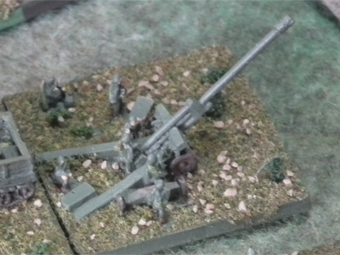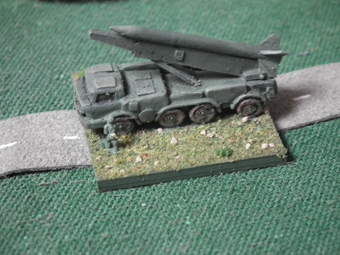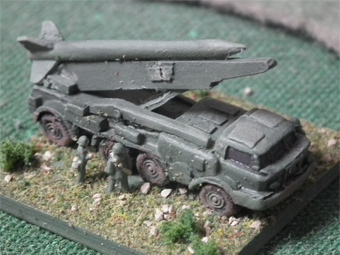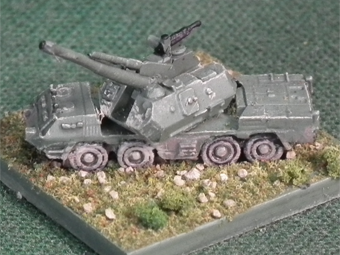

This page last modified: 13 November, 2013 (larger M-30, A-19 & BS-3 pictures added, plus associated blurb).



Of course, vz.51s should have 32 tubes rather than just 16 like the BM-14 does, but you have to get quite close to the model to be able to count the difference... Studebakers get used in all sorts of roles in my table-top army, and that's fine, because many of them found their way into the Czechoslovakian army.
In game terms, each Motor Rifle Regiment gets a pair of these MRL
stands, simulating the consolidation of each battalion's two real-life
vehicles into a regimental asset. It is these elements that really
distinguish the Czechoslovakians from any other on-table force in MSH,
since they behave very differently from the battalion-level 120 mm
mortars they replace in other WarPac armies (the Czechoslovakians
have 82 mm mortars at battalion level as well if you need some smoke).
The rockets' very short range (just over 8 km) means they are horribly vulnerable to counter-battery fire, but, with luck, they can do a lot of damage for very little points investment. My favourite in-game part of the table-top army, but the results from using them are really random.





The vz.70 re-equipped various units that had formerly used the vz.51. The first units were the divisional-level rocket battalions, starting with those of the 20th Infantry Division and the 9th Tank Division in 1971; the released vz.51s were then incorporated as pairs into the infantry battalions as discussed above. The 3rd Division that I often use had to wait until 1979 to get its vz.70s. The 7th Artillery Division's 74th Rocket Brigade converted in 1976 (4 Battalions' worth, for 72 launchers), although this was a war-time only formation, so the newest gear effectively went straight into storage in this particular case; this also happened when the 1st and 4th Army's mobilization-only brigades were formed in 1985 and 1986, respectively. Armour certainly helps vz.70s survive counterbattery fire in ways the vz.51 can only dream about; having a range of nearly 21 km also greatly helps. Somewhat bizarrely however, MRLs, unlike tube artillery, don't benefit from actually being self-propelled in MSH in terms of not being located in the first place, which is precisely the opposite of what you would expect: firing MRL batteries are so easy to detect they absolutely have to be mobile to have any chance of avoiding being located by enemy counterbattery locators, which is precisely why nobody fields towed MRLs in real-life (outside niche applications like airborne troops).


Above left is a Czechoslovakian infantry regimental battalion of vz.38 122 mm howitzers (i.e. Soviet M-30), minus their observer, who is evidently off somewhere else looking for targets (tank regiments of ca. 1980 had a battalion of 18 vz.51 MRLS instead). These venerable pieces have an abyssmal range (less than 12 km, even after their refurbishment in the 1970s; in MSH even an Abbot can counter-battery them to death!), but that's what you are stuck with a 2nd-echelon division like the 3rd Motor Rifle Division. 1st-echelon ("full-strength") Divisions replace these with imported Soviet D-30s in the 1980s, or, for privilged units, 2S1 self-propelled pieces. 18 real-life tubes get simulated as 4 stands under MSH, a somewhat unhappy compromise for 3 batteries each with six pieces. But is does make fielding under-strength 3-stand-strong battalions a very acceptable table-top practice!
These are H&R models. H&R currently advertise them as S32 WWII Soviet mark 1938 152 mm pieces, but they look more like 122 mm M-30s to me. However, as the two marks shared the same gun carriages, the resemblence is not coincidental. The trucks are, again, Studebakers, although I now have proper AT-S and ATS-59Gs to pull them, if desired. Unlike Scotia artillery, H&R artillery pieces come with a strip of six crewmen which is very handy; you can also buy extra crewmen, standing or kneeling, two strips (12 men) per pack.

This picture shows another M-30 / vz.38 artillery piece, but towed by one of my Tatra 111 trucks from Shapeways. The artillery crewman standing up holding binoculars is one of the most useful figures H&R produce. I use this figure extensively not just on artillery stands (where he is really only appropriate for direct fire weapons), but also to identify tank command elements - he gets cut off at the waist and stuck on a turret hatch in this case. Similarly, artillery observer elements in vehicles that can also be used as normal recce elements get this guy to distinguish them from the normal recce vehicles, as it is very common for the two to be found close together on the tabletop.


To the left is, if my memory serves correctly, a Scotia Zil-157 truck (rear contents added by me) along with an H&R vz.31/38 122mm field gun (i.e. a Soviet A-19). However, it gets used on-table as vz.18/47 152 mm howitzer, a single stand of which each motor rifle regiment gets before the divisional-level reorganizations that occured in the 70s (1979 in the case of the 3rd Division). The vz.18/47 is an ancient piece (a re-bored WW2 German 150 mm howitzer), with poor range (15 km) for a heavy gun, even worse than the WW2-era ML-20 found in many other WarPac armies (17 km), to say nothing of the post-WW2 Soviet D-20. From 1979, these stands move into divisional support, enlarging the divisional heavy howitzer battalion from 3 to 4 elements.
I keep these looking like A-19s, rather than cutting them down, because A-19s were also used by Czechoslovakian for longer range work (over 18 km) by the army-level artillery brigades (later they were mostly replaced by imported M-46s with their 27 km range). A-19s actually have a better in-game reason to be on-table than vz.18/47s, since they retain somewhat more utility as anti-tank guns.

This picture shows another A-19 artillery piece, but towed by one of my ATS-59G tractors from myShapeways shop. While the Czechoslovakians made use of the ZiL-157, I am not sure they used it as an artillery tow. They certainly did make use of the AT-S and ATS-59G artillery tractors in this role, however, along with the similar Mazur D-350, of Polish origin. In MSH a tracked artillery tow is generally much better than a wheeled one, as although it loses 3" of speed when towing a gun along a road (9" against 12"), it doesn't lose speed crossing light hedges or going uphills, which are much more important considerations when towing artillery around the battlefield, especially when the base movement is only 6" a turn. With a wheeled tractor, it will take you more than one turn just to ascend the average hill, and then you still have to unlimber on top...



Where every anti-tank gun should be: in cover! Above left is a 100 mm field gun from Heroics and Ros, but what is pictured is the 1944 Soviet BS-3 field gun rather than the equivalent Czechoslovakian vz.53: their gun shields are quite different. The 3rd Divisions's AT battalion had 3 batteries fielding the vz. 53, each of 6 guns, which translates to 4 stands on the table in MSH. Some, but not all, sources indicate that, like in the 1st echelon divisions, one battery was converted to 9P133 in the 1979 reorganization - i.e. BRDM-2 armoured cars equipped with AT-3 Sagger launchers. 9P133 stands are, in my opinion, excessively expensive points-wise in Keith's system (at least, compared to much more capable 9P148 system), but they are basically the only things the Division possesses that can touch e.g. a Chieftain frontally, so are sometimes definitely worth the points investment.
Interestingly, while the Czechoslovakians produced a similar 85 mm gun in 1952, it was relatively quickly withdrawn from service, as it lacked the necessary oomph (the BzK.59 82 mm RR was almost as good in terms of firepower, and far lighter), whereas the Poles went the opposite route. They kept their 85 mm guns in service right into the 90s, but withdrew their 100 mm guns in the 60s as being insufficiently mobile in the field (the Poles also used the Soviet man-portable 73 mm RPG-9, unlike the Czechoslovakians with their heavier BzK).
The towing vehicle in the centre is pretending to be a Tatra-813; the model is actually a Heroics & Ros MAZ-535, which the Czechoslovakians didn't use, but converting it into the Tatra equivalent would be a real chore, since not only would the rear half of the cab have to come off, but the canvas top would have to be extended to fill in the resulting gap. Altogether too much work!
On the right is a genuine T-813 model, from Karl Heinz' range. Naturally I found out these models existed a month after I bought my MAZ-535 tractors, but that didn't stop me buying some of Karl Heinz' gear! Very nice indeed. The canvas top and excavator blade are supplied separately, too. You'd think such large artillery tractors as this would be dedicated to towing really heavy things all the time, but I've seen photos of them towing pieces as small as 57 mm S-60 AA guns (this isn't as silly as it sounds, because a 57 mm AA piece isn't all that light. The extra stuff you need to enable high-angle fire, etc. really adds to the weight).

Above is another of my H&R BS-3 models, this one towed by another of my ATS-59G variants from my Shapeways shop. 100 mm field guns were frequently used in the indirect fire role, as their long range and rapid rate of fire made up for their light shell weight, and this is why I've shown them here rather on the anti-tank weapons page. In an attack game, this is likely the only use you will get out of them as well, because moving these things into position so they can engage an enemy that won't come to them is almost impossible.


Here is an M-46 field gun, along with an AT-T heavy tractor. The M-46 model isby Scotia, with H&R crew, of course; the tractor has had various kinds of stuff added to the back, mostly in the form of boxes, for shells, etc. The M-46 was conceived as an anti-tank gun, but almost never used in that role, because its exceptional range for the time, 27 km, made for an exceptionally capable artillery piece for striking at distant targets such as HQs, or other artillery batteries. The barrel is accordingly exceptionally long: there is no way to get the trailing legs onto the base without the barrel overhanging the front of the base. Of course, in the normal run of things, they are never fielded on-table anyway, being an exemplar of off-table artillery support. Being heavy pieces, I've given these models 7 crew figures each; most of my artillery stands have 6, or 5 if small. Six figures are what you get on a single H&R crew strip; they come two strips per 40 pence pack.
The Czechoslovakia army received their first M-46s in 1976, reequipping the 7th
Artillery Division's four field gun battalions that had been armed with the 122
mm A-19 (vz.31/37 to the Czechoslovakians); a few more followed over the next
couple of years, equipping a single battalion in each of the two Army-level gun
artillery brigades. Another battalion in each Army was equipped with them in 1985. As Army-level assets, in MSH they don't come with observer elements, limiting them to pre-planned or counterbattery tasks, but their range makes them worth it. Unfortunately, with just 4, 6 or 8 battalions available to the whole army depending on the date, you would be hard pushed to justify having more than one battalion in your OOB unless you were looking at a game involving a full division or more.



Here's a battalion of 2S1 self-propelled 122 mm howitzers, with its associated 1V12 stand shown to the right. 1V12 is the designation for the battalion's complete set of fire control vehicles. The battalion commander's observation vehicle is called a 1V15, and the three battery commander's observation vehicles are designated 1V14. The three battery fire control vehicles, which stay with the batteries commanded by each battery's 2iC, are called 1V13, while the battalion 2iC's fire control vehicle is the 1V16. In MSH, the 4 fire control vehicles aren't represented, while the 4 forward observer vehicles are subsumed into a single FO element (some can be assumed to be accompanying various BHQ and/or RHQ elements). The model is a good one, with crisp details. I believe that's a tarpaulin rolled up on the back.
In 1973, the Czechoslovakians planned on producing 640 2S1s to replace
the venerable vz.38 122 mm howitzers that served as regimental-level artillery assets in the motor rifle regiments, as well as the rockets launchers that served in the tank regiments. However, economics got in the way of that plan, and in 1976, they decided to just import them rather than produce them domestically, and scaled the number back to 340. But even that plan was modified in 1981, so that only 148 were actual imported. The remaining numbers in the first echelon divisions were filled by importing D-30 towed guns, while the second echelon units like the 3rd Division retained the vz.38 throughout the 80s. I use these 2S1 models if I want to model a first echelon drawn from e.g. the 1st Tank Division or the 20th Motor Rifle Division.


And here are some D-30s. The 20th Division, being the Czechoslovakian Army's best infantry formation, received 2S1s for its Tank and BVP Regiments (1 Battalion of 18 guns each), but the two OT-64 regimental battalions, as well as the two divisional-level 122 mm battalions had to make do with the towed equivalent: the D-30.
122 mm guns aren't all that good in game terms. Their AI factor of 5, as opposed to the 6 that 152 mm pieces have, equates into a significantly less lethal barrage, nowhere near compensated for by them having (potentially) 7 turns of fire available as opposed to the 6 shots the bigger guns get. I say potentially, because if you are WARPAC-2 like the Czechs are, you'll almost never get to dial in 6 shots, let alone 7; and this is doubly so for towed guns, which are extremely vulnerable to being counter-batteried to death. Of course, they are slightly cheaper in game points - but only slightly, because the cost of the battalion's observer element is not decreased at all, seriously diluting the points advantage of the smaller guns.
The D-30 has a significantly different carriage design from the other artillery
pieces in my collection; its tripod arrangement enables the gun to be positioned
low down (notice also, if you can, how the wheels are raised off the ground). Soviet doctrine required field artillery pieces like the D-30 to retain significant direct-fire
capabilities, hence the guy with the binoculars observing to the right. In
some ways, this was a hangover from WW2, when the Soviets didn't usually have enough ammunition to "waste" on unobserved shots, so direct fire was encouraged. It is well-known that the Soviets made enormous numbers of artillery pieces like the ZiS-3, but it is less well known that half of all their ammunition in WW2 was supplied to them via lend-lease.


And this is a 9K52 Luna-M launcher, aka FROG-7 in the West, from the 3rd Division's 14th Independent Rocket Battalion. Exactly when the battalion re-equipped with the Luna-M is obscure: in 1969 it was equipped with the 2K6 Luna tracked launcher (FROG-5 or FROG-3 in NATO-speak, depending on whether it was carrying a nuclear warhead or not), but it definitely had the 9K52 later.
In MSH, the entire battalion gets abstracted down to this single launcher element, since each of the battalion's two batteries had just two launchers. The rules have some rather strange notions about what SRBMs are (or were) for. As an aside, I have to assume here that the rules' "SRBMs" covers tactical ballistic missiles, because otherwise the most relevant SSMs to a divisional-level game wouldn't be covered at all! It says SRBMs are generally theater-level weapons used to deliver chemical and nuclear weapons. Let's examine each claim, bearing in mind the vast majority of these weapons were found in WarPac or WarPac-supplied armies, so we should use WarPac systems as our baseline. Let's take deployment level. The big ones like Scuds were (to use WarPac terminology) found at the army and front-level. While front corresponds to theatre, more were found at the army level. Furthermore, FROGs were divisional-level weapons. So a while some SSMs were theater-level; the majority were not. Now let's look at payloads. Scuds could carry nuclear, chemical, and HE warheads. Certainly nuclear payloads were envisaged in the standard "race for the Channel" WWIII scenario developed by Soviet strategists, but of the nearly 2000 Scuds that have been actually fired in anger, as far as can be determined, every one of them has ended up carrying an HE warhead. With respect to FROGs, the situation is perhaps even more extreme: nuclear warheads envisaged, certainly, but HE is what actually gets fired; and unlike Scuds, the FROG series didn't even have a chemical warhead option until the FROG-7 came out! The Czechoslovakians deployed ten battalions of FROGs in the 1960s that, if you take the rules at face value, would have had no purpose, since the Czechoslovakians had no nuclear warheads of their own - they had to be supplied by the Soviets, and there weren't any chemical warheads developed yet. Not that I think SSMs, at least crude ones like Scuds and FROGs, should be effective as HE-delivery platforms, far from it (moderns precision SSMs are different kettle of fish), but they are a weapon system that has actually been used an awfully lot in modern warfare; more than can be said of the chemical weapons, to say nothing of nuclear weapons, that get much more attention from rules writers. As is typical of MSH, the rules seem to be geared to American ideas, equipment and terminologies, despite Soviet stuff being much more important in terms of both numbers and real-life usage.




Ah! - that most Czechoslovakian of vehicles - the unique profile of the vz.77 DANA. These are the new H&R model, released at the end of 2012. The first fighting formations to transition to the DANA did so in 1979, although not in my 3rd Division, which had the towed vz.18/47 right to the end. These ones belong to the 4th Army's 332nd Artillery Brigade, 3rd battalion, which got them in 1985. If I want to use them earlier than that, I have to give up on the 3rd Division and play something like the 20th, which got them in 1980. The models are nice - although they should be, since they aren't as cheap as the standard H&R offering! Crisp lines; little flash; and the turret captures well the asymmetry of the prototype. The gun has a clever arrangement it which it can easily sit either up like this, or down, in travelling position.
The DANA was the world's first wheeled, rather than tracked, gun-howitzer; the configuration has since been emulated by e.g. the South African G6 and the Serbian Nora B-52; it achieved some degree of export success, being used by Poland, Libya, and even the Soviet Union. After the break-up of Czechoslovakia, some were also used by Georgia, where they saw service in the Russian-Georgian war in 2008. A modified version, with a NATO-compatible 155 mm gun, is used by Cyprus, and also by Slovakia alongside older 152 mm DANAs. Polish ones have seen service in Afghanistan.
Back to my photos top page.